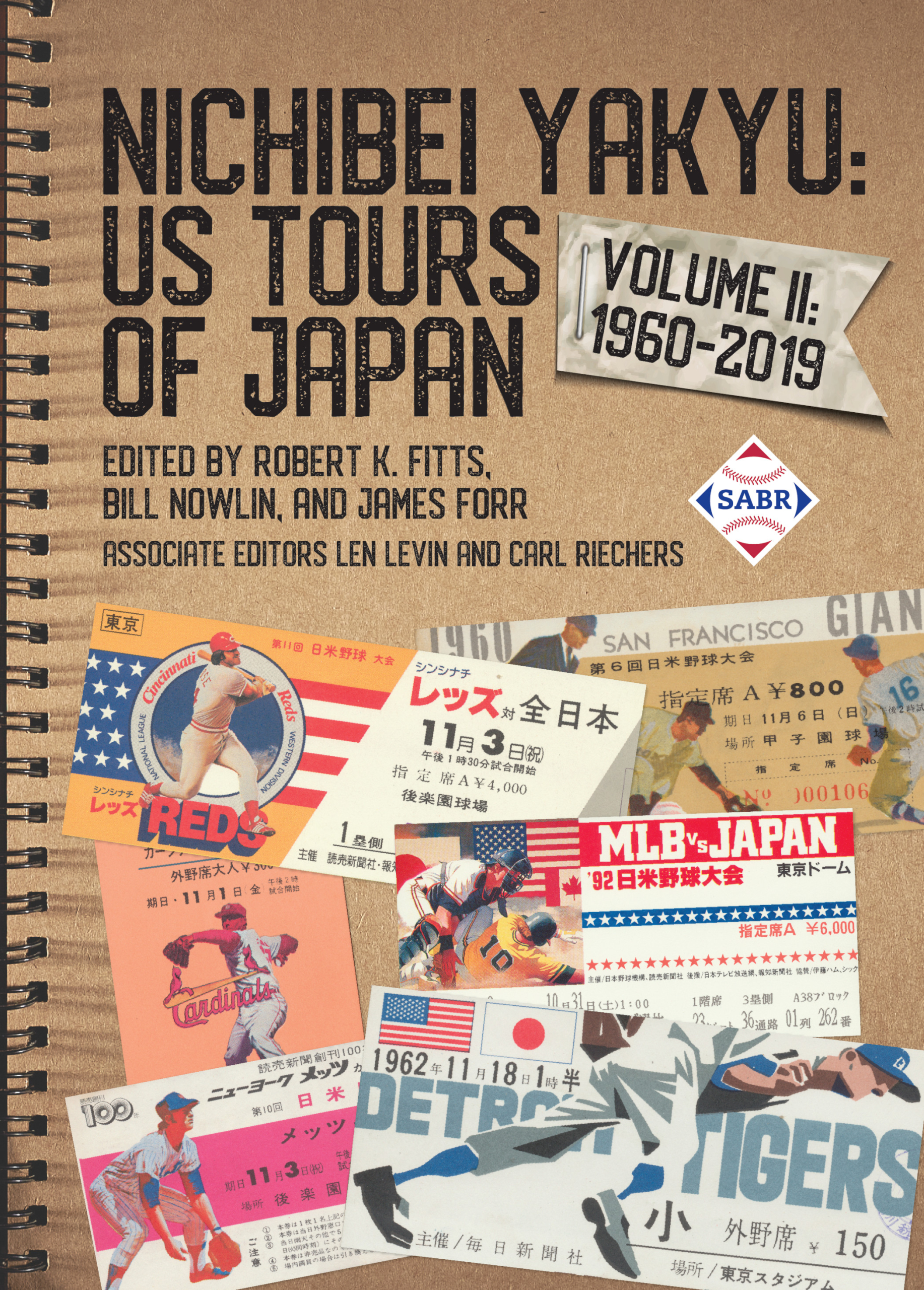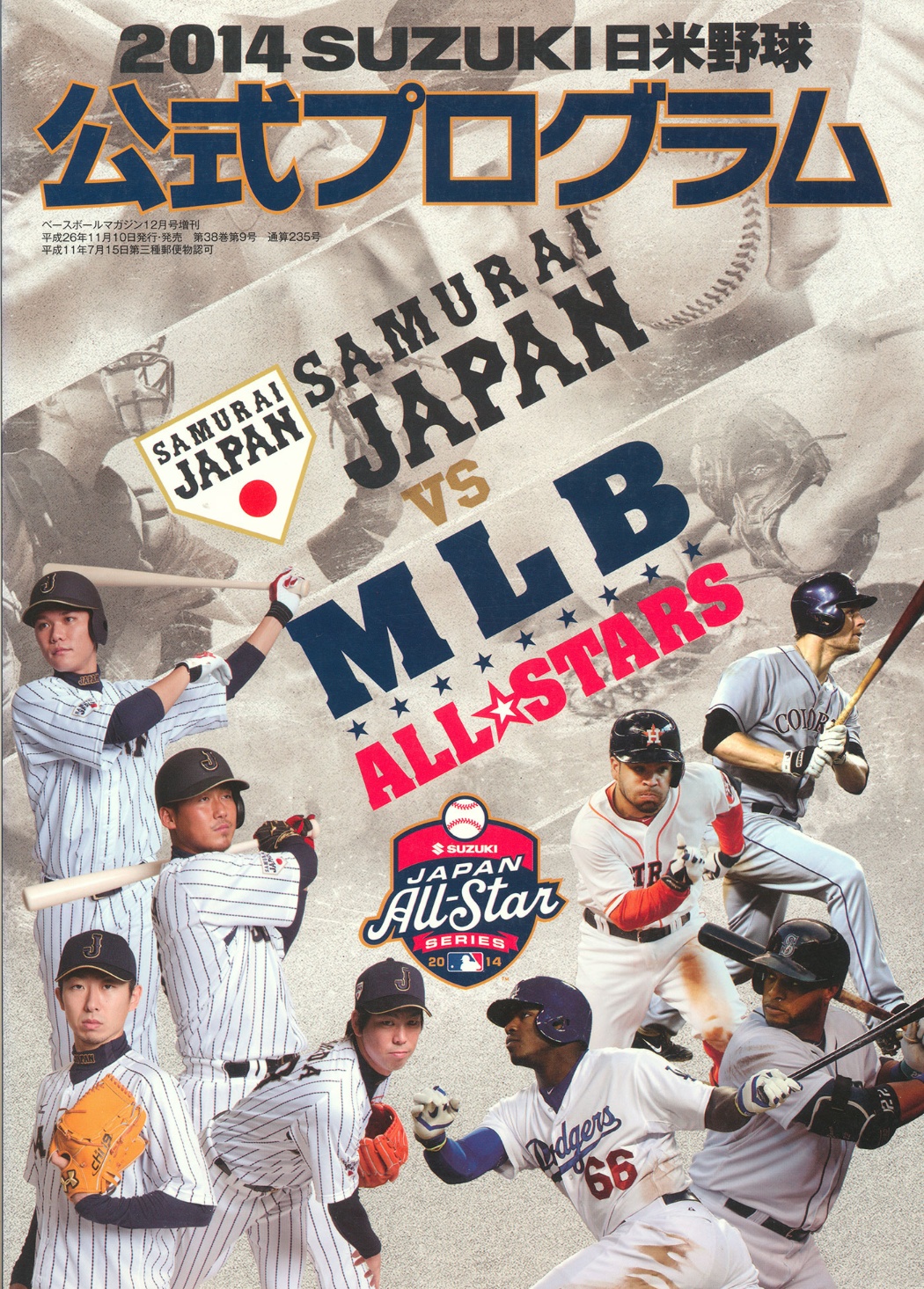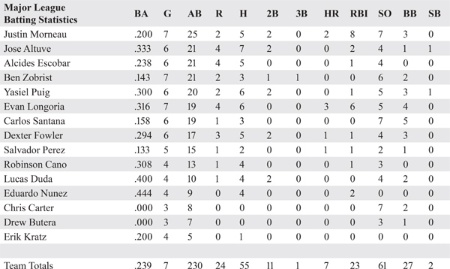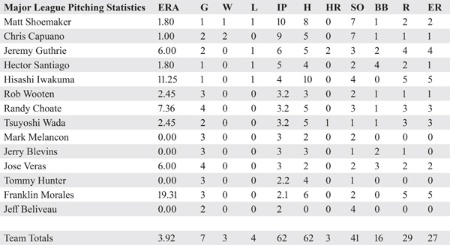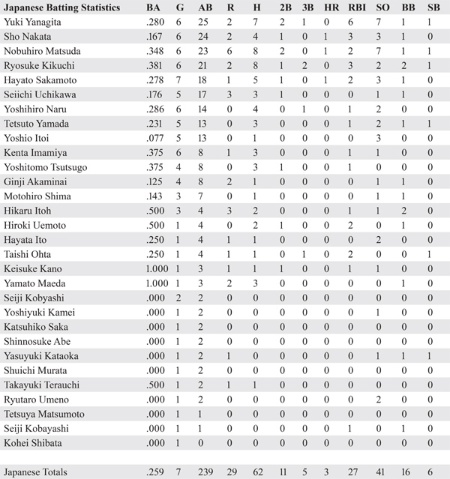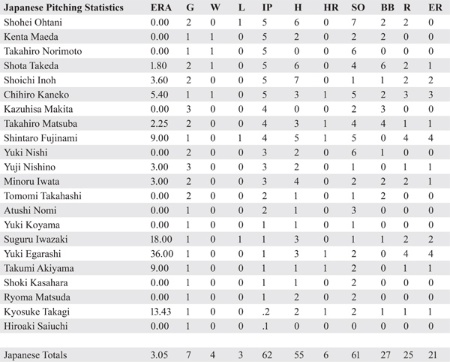2014 Suzuki All-Star Series: Samurai Japan vs. MLB All-Stars
This article was written by Carter Cromwell
This article was published in Nichibei Yakyu: US Tours of Japan, 1960-2019
2014 Suzuki Nichibei Yakyu program (Robert Fitts Collection)
On June 10, 2014, Major League Baseball and the Major League Baseball Players Association announced that the Nichibei Yakyu All-Star Series would be held in the fall after an eight-year hiatus. In 2006 the Japan Professional Baseball Players Association had voted not to participate in the event after 2006 as the World Baseball Classic had made MLB-Japan all-star exhibition series meaningless. “The majority of the players felt the series, an exhibition, placed a great burden on the players in an environment in which meaningful competitions, including the World Baseball Classic, existed, and that the historic role of the regular All-Star Series had run its course,” explained Takuya Yamazaki, an attorney for the players union.1
Although Jim Small, president of Major League Baseball Japan, worked to restart the series, the players union maintained its stance until early 2014, when it agreed that resuming the series would be mutually beneficial. Japan had won the World Baseball Classic in both 2006 and 2009 but had finished third in 2013. The squad needed an edge to regain the championship. Instead of bringing together a group of all-stars to face the major leaguers as they had done in the past, the Japanese decided to pit their national team, Samurai Japan, against the MLB All-Stars.
“Samurai Japan is about winning the WBC and this is part of that buildup and the players are behind it,” said Toru Matsubara, the secretary general of the Japan Professional Baseball Players Association.2 “We don’t see these games as exhibitions,” added Kenjiro Kato, a national team senior staff member. “We are treating them as meaningful competitions.”3
Led by Samurai Japan manager Hiroki Kokubo, the Japanese squad consisted of the national team players not under contract to major-league teams. Masahiro Tanaka and Ichiro Suzuki of the New York Yankees and Yu Darvish of the Texas Rangers, for example, were ineligible. But the squad contained plenty of top players including Tetsuto Yamada of the Tokyo Yakult Swallows, Yuki Yanigata of the Fukuoka Softbank Hawks, Ryosuke Kikuchi of the Hiroshima Carp, and 20-year-old two-way player Shohei Ohtani of the Hokkaido Nippon Ham Fighters.
To face Samurai Japan, MLB would once again send a team of all-stars. Commissioner Bud Selig announced, “Major League Baseball is delighted that many of our finest players will represent our sport during the 2014 Japan All-Star Tour.”4 But there were questions from some about whether the US team was truly all-star caliber. After the roster was announced, Jon Heyman of CBS tweeted, “appreciate their service, but of the mlb ‘all-stars’ playing in Japan, 21 of 29 players were never all-stars.”5 This is not to say that the MLB club was a bad one – not at all. It included Jose Altuve, Robinson Canó, Yasiel Puig, Evan Longoria, and Justin Morneau. But there were others who were solid major leaguers but could not be considered all-stars – for example, Erik Kratz, Drew Butera, Tommy Hunter, Jeremy Guthrie, Jerry Blevins, and Jeff Beliveau.
The team also included two Japanese-born players. Hisashi Iwakuma had played in Nippon Professional Baseball for 11 seasons, winning the 2008 Eiji Sawamura Award and two Best Nine Awards, before signing with the Seattle Mariners in 2012. He became the team’s best starter in 2013 with a 14-6 record and 2.66 ERA as he finished third in the American League Cy Young Award voting. This was Iwakuma fourth Nichibei All-Star series. He played for the Japanese team in 2002 and 2004 and for the major leaguers in 2012 and 2014. Tsuyoshi Wada, a former star with the Softbank Hawks who struggled with injuries after signing with the Baltimore Orioles in late 2011, had a breakthrough season with the Cubs in 2014, earning him a spot on the MLB team. “It’s an honor, even though I feel a little weird being on the American side,” Wada said. “But it’s going to be something I treasure for all of my baseball life.”6
The MLB All-Stars congregated in Los Angeles on November 7 and spent two days working out before arriving in Osaka, Japan, on Sunday, November 9. The team practiced the next day in preparation for an exhibition game against a team made up of players from the Hanshin Tigers and Yomiuri Giants.
The opening exhibition took place on November 11 before a crowd of 26,946 at Koshien Stadium, home of the Hanshin Tigers. The game celebrated the 80th year of professional baseball in Japan, and the Japanese players wore uniforms identical to those worn by the All Nippon team during the famous 1934 All-American tour led by Babe Ruth, Lou Gehrig, and Jimmie Foxx.
The MLB All-Stars took a 2-0 lead in the fourth inning when Alcides Escobar scored on a double-play grounder by Carlos Santana, and Yasiel Puig later drove in Robinson Canó with a single. Then the major leaguers displayed their power – a fifth-inning grand slam by Evan Longoria off reliever Yuki Egarashi of Yomiuri and solo homers by Salvador Perez in the sixth and Dexter Fowler in the seventh gave them an 8-1 lead.
MLB starter Chris Capuano of the New York Yankees pitched four scoreless innings, giving up only one hit, walking one batter, and striking out three. “Overall, I pitched pretty well,” Capuano said. “It wasn’t cold out there. Actually, it was perfect for pitching.”7
After scoring their first run in the bottom of the sixth on Hiroki Uemoto’s RBI double, the Japanese then scored five times in the seventh, highlighted by a two-run triple from Yomiuri’s Taishi Ohta off reliever Franklin Morales. The Japanese got another run in the eighth inning on a fielding error by Jose Altuve, who was making a rare appearance at shortstop, to narrow the score to 8-7, but they could get no closer. “Tonight was more than we could have asked for,” MLB manager John Farrell said. “We were able to get every position player on the field [and] were able to go to our bullpen, but their competitiveness forced us to make some plays.”8 Rob Wooten, a pitcher for the Milwaukee Brewers, was impressed with historic Koshien Stadium. “When Babe Ruth and Lou Gehrig and that team went over in 1934, that’s where they played. So it’s kind of like their Fenway. It’s a really old ballpark, but it’s pretty neat. … I hadn’t played on an all-dirt infield since Little League, so it was different in that aspect. Even from the mound to home plate, it looked very different, being all dirt.”9
Game 1 of the five-game series, the first against the Japan national team, took place the next day at the Kyocera Dome in Osaka. Samurai Japan took a 2-0 victory behind five strong innings by starter Kenta Maeda of the Hiroshima Carp. A series of relievers, highlighted by Shohei Ohtani’s one-two-three eighth inning, maintained the shutout. The major leaguers got only three hits.
The Japanese scored two runs off starter Matt Shoemaker of the Los Angeles Angels, who had just completed a fine rookie season with a 16-4 mark, and those proved to be enough. Nobuhiro Matsuda of the Softbank Hawks hit a sacrifice fly in the second to score Softbank teammate Seiichi Uchikawa. In the fourth inning, Matsuda reached on an errant throw by second baseman Canó and scored on an RBI single by Tetsuto Yamada. “[B]eing able to score early was big,” Japan’s manager Kokubo said. “I was really proud of our pitching staff tonight.”10
Maeda, rumored to be a candidate to jump to the majors (though that did not happen until 2016), allowed a one-out single to Canó and then walked Longoria in the first inning before settling down and getting out of the inning. He gave up two hits and two walks and threw 71 pitches in five innings. “I am happy to finish my outing with a good result, especially in the first official game of the series,” Maeda said. “They made me throw a few more pitches than I wanted in the first inning, but I got my rhythm after that.”11 Farrell added, “Very good pitching on their part tonight. We got an opportunity in the first inning … but Maeda really settled in with an assortment of pitches for strikes.”12
Ohtani, then 3½ years away from his major-league debut, thrilled the crowd and impressed the major leaguers with a fastball that reached 98.8 mph. “To see a guy who’s his age [20] throw nearly 100 miles an hour, that’s an impressive-looking young pitcher,” Farrell said. “It seemed like he had very good poise [and] … a long, loose body that’s got tremendous arm speed.”13 Morneau added, “He’s young, but he didn’t look scared at all. He was attacking. I think at his age, to be able to throw that hard and throw the ball over the plate is the most important thing. If you can locate and throw that hard, you can be as dominant a pitcher as anybody. He’s young, so he’ll be here for a long time.”14 Fowler concurred: “He’s good. Great arm. He’s aggressive, which is awesome. You don’t see that often from a young kid.”15
The teams had a day off before playing November 14, 15, and 16 at the Tokyo Dome. In Game 2 the Japanese pounded out 14 hits in an 8-4 victory. All but two of Japan’s runs were scored after two batters were out. “They did a very good job of not giving in to record that third out,” Farrell acknowledged.16 Center fielder Yuki Yanagita of Softbank led the attack with a single, double, and triple and four RBIs. For good measure, he also stole a base. Ryosuke Kikuchi of Hiroshima went 3-for-5 and drove in two runs; Nobuhiro Matsuda of Softbank had three hits, including a solo home run; and Hikaru Itoh of the Orix Buffaloes had two hits and an RBI.
Both of the Japanese-born players on the MLB team had disappointing performances. Starter Iwakuma gave up five runs in four innings, and relief pitcher Tsuyoshi Wada allowed two runs in 1⅔ innings. “I was so nervous out there,” Iwakuma said. “I couldn’t really have a good performance, but I’d been looking forward to pitching back at home and I had a lot of fun.”17
Reliever Rob Wooten, who relieved Iwakuma in the fifth inning, noted that the bullpens at Tokyo Dome were not behind the outfield walls but underneath the field, near the clubhouses. Their isolation led to a shock when he entered the game. He said:
The first time you’re exposed to the [game’s] atmosphere is when you’re on the mound. You’re in the bullpen and it’s dead quiet and you’re watching the game on TV … and then all of a sudden you’re in mayhem – horns, drums and all kinds of stuff. You really have to calm your emotions down real quick. If you let your emotions get to you, you’re going to be pretty jumpy out there. I did a pretty decent job of that and got right to work. … [T]he first pitch I threw was a strike, so that calmed me down.
They have very good fans with a high baseball IQ. I noticed most of the time it was really, really loud when they were hitting but pretty quiet when they were pitching. For instance, I noticed when it was two strikes and two outs and all they had to do was get one out to win the game and the series, nobody was standing. Nobody was clapping. It was extremely quiet – here in the States, your closer is on the mound and there are two outs, 40,000 people are standing and cheering to get that last out – but then once the out was made, everyone started standing up and clapping. But when they are hitting, it’s a whole different world. There’s cheering, people jumping around … horns … drums. … It’s just, wow.18
Samurai starter Chihiro Kaneko recorded the win, surrendering three hits and three runs while striking out five in five innings. Justin Morneau hit a two-run homer off Kaneko in the second inning, scoring Longoria ahead of him, but the Americans could do no more damage. “[Kaneko] made pitches when he needed to,” Morneau said. “We never really got anything going. We never really got any rallies going or situations where we could put a lot of pressure on him. He was able to get ahead and then … throw his split and get us to chase [it].”19
Asked if the results of the first two games indicated that the gap between the level of play in Japan and the major leagues was closing, Yanagita joked, “I don’t think they’re really playing seriously, are they? I don’t know, though. Today, I was lucky that I was able to make good contact.”20
The series went from bad to worse for the visitors. The next night in game 3 as four Samurai pitchers – starter Takahiro Norimoto (Rakuten) and relievers Yuki Nishi (Orix), Kazuhisa Makita (Seibu), and Yuji Nishino (Chiba Lotte) – combined to no-hit the Americans en route to a 4-0 victory. It was the first time in history that Japanese pitchers had no-hit a visiting American professional team.
Norimoto, who struck out six batters and retired all 15 he faced, said, “I did more than I thought I was capable of. It felt so great. This is a big stage we’re playing on, so I’d say it was the best pitching I’ve ever done.”21 Farrell commented, added, “He attacked the strike zone. … [W]hen you have that power of 94-96 (mph) with some late action … [you are a] very difficult pitcher to face. Even in some fastball counts, he did an outstanding job of locating his fastball down at the bottom of the strike zone. … On a night like tonight, you tip your hat to a very good pitcher.”22
Hayato Sakamoto of the Yomiuri Giants and Sho Nakata of the Nippon Ham Fighters hit two-run homers in the second and third innings respectively to account for Japan’s runs. The no-hitter was nearly spoiled with one out in top of the ninth when Carlos Santana hit a sharp grounder to the right of second baseman Ryosuke Kikuchi, but the gold-glover made a sliding stop, spun completely around, and easily threw out Santana at first. As if being no-hit was not bad enough, the MLB squad also lost star second baseman, Robinson Canó, who was hit on the right foot by a pitch in the seventh inning. X-rays revealed that he had a fractured toe, ending his participation in the series.23
The victory also clinched the five-game series for Samurai Japan. “It was our goal to win the series, so I’m happy we’ve achieved that. Especially in a game that made history with the first no-hitter by Japanese pitchers,” manager Hiroki Kukubo said.24 “I’m so happy that we were able to win the series,” added Nakata. “I wasn’t really able to contribute to the team in the first two games, and finally I was able to contribute to win in the game that clinched the series.”25
“Obviously, they’re the best in Japan,” said MLB all-star Lucas Duda when asked about the Samurai’s success. “I really didn’t have an original notion of what they would be. I knew they would be good. I didn’t know how good. I didn’t think they were going to be this good.”26
A day later, the MLB All-Stars finally got going, rapping 10 hits, including home runs by Morneau and Longoria and 3-for-4 performances by Altuve and Puig, to win 6-1. The Americans got a run in the first inning, three in the third, and one each in the sixth and eighth. Farrell moved Puig from the sixth spot in the lineup to second, ahead of Morneau, and he felt that made a difference. “We had to make some adjustments. … [T]hey were attacking Yasiel in the first three games and not really giving him too much to hit. To put him in front of Morneau … was an opportunity for him to see some pitches and it worked out. They threw the ball in the strike zone and he responded.”27
Meanwhile, starter Chris Capuano gave a five-inning, one-run performance to get the victory. The only Samurai run came off Capuano in the second inning when Yoshitomo “Yoshi” Tsutsugo of the Yokohama DeNA Baystars hit an RBI double to drive in Matsuda.28 “It was helpful being able to watch the Samurai team for a few games before I had to pitch against them,” Capuano said. “I was trying to watch what our pitchers, especially our left-handed pitchers, were throwing, and I think that helped me.”29 “The top third of our lineup [Altuve, Puig and Morneau] did an amazing job,” Farrell concluded, “and with Chris, his ability to pitch in with his fastball and use his changeup effectively, it kept them off balance.”30
No game was scheduled for November 17. Players used this, and other free days, to sightsee, shop, and experience Japanese culture. After the first game in Osaka, for example, the players visited Kyoto, stopping at many of the famous sites. Jeremy Guthrie visited Kiyomizudera Temple and drank water from the Otowa Waterfall at the fountain of wisdom.31 Guthrie, whose great-grandfather was a Japanese immigrant to Hawaii, also met Japanese cousins for the first time and visited his great-uncle’s gravesite.32 Rob Wooten and his wife, Katie, toured a few temples before having a traditional lunch and geisha show.33 “I’ll remember most the Japanese temples and shrines we visited,” Chris Capuano told reporters. “The natural beauty of that place, and the peace and serenity that came with being in those places was something that I’ll definitely take with me.”34
“I came here for baseball,” said Hector Santiago, “but I said I was going to try and do everything single thing that I could. I tasted the tea. I was a little nervous about it at first … but it wasn’t too bad. … You’re only here for about 10 days but you try to go every day and do and see something new. … It’s pretty cool.”35
The teams then traveled to Sapporo to play the final game of the series on November 20 before a crowd of 30,159 at the Sapporo Dome. Shohei Ohtani started for Samurai Japan in front of his home crowd and struck out seven batters in four innings, but allowed two walks, four hits, and two runs while hitting one batter and throwing one “hard-to-catch pitch” that resulted in a run-scoring passed ball as the MLB All-Stars won, 3-1.36
Lucas Duda of the New York Mets came home on the passed ball in the third inning to start the scoring. Later in the inning, Jose Altuve’s groundout scored Alcides Escobar from third base for a 2-0 MLB lead. The All-Stars scored their third run in the sixth inning, and the Japanese got their only run in the seventh. The major leaguers banged out 12 hits to Samurai Japan’s four. Altuve went 3-for-5, and Puig, Escobar, and Eduardo Nunez each had two hits.
“They hit me when I tried to get ahead in counts, and I need to look at that,” Ohtani said. “I also should have paid more attention to the leadoff batters [who reached base in three of his four innings]. The good thing was that I was able to get strikeouts when I needed them.”37 Despite his uneven performance, Ohtani nonetheless again impressed the major leaguers. “He was the best,” Escobar said. “He’s throwing 95 (miles an hour) and down in the zone. That’s tough.”38
Starter Matt Shoemaker gained the victory, surrendering just two hits in five innings. “It was definitely a great game for us,” he said. “We had a lot of fun out there. This is a great team, a great group of guys.” Shoemaker added that the Japanese “put the ball in play. They foul off a lot of pitches, with very good speed. … These hitters are very good.”39 He also praised Ohtani. “He’s what, 20 years old? That’s impressive enough. Let alone that he has that kind of an arm, maybe he can be a two-way player.”40
After the five-game series, the teams traveled to Okinawa to play an exhibition game on November 20. The MLB All-Stars got a first-inning run on a sacrifice fly by Morneau, but the Americans failed to take advantage of a bases-loaded, two-out situation, and scored only the one run. The Japanese tied the game in their half of the first when Softbank’s Kenta Imamiya singled off Hector Santiago to score Seichi Uchikawa. Excellent defensive stops by shortstop Imamiya and center fielder Yuki Yanagita in the third inning kept the All-Stars from scoring, before throwing errors by Longoria and Fowler in the fourth gave the Samurai a 2-1 lead.
Japan added a run in the fifth inning when Yoshio Itoi of Orix tripled off Tsuyoshi Wada to score Ryosuke Kikuchi, but the All-Stars responded with a run of their own in the bottom of the inning to keep it a one-run game. The Samurai broke the game open in the top of the eighth as Nobuhiro Matsuda led off with a double and reliever Jose Veras then walked Ginji Akaminai. After an unsuccessful and a successful sacrifice bunt, Yanagita singled home both runners off Randy Choate to stretch Japan’s lead to 6-2. Kikuchi then tripled, scoring Yanagita. Although the MLB All-Stars scored single runs in the eighth and ninth innings, the Samurai took home a 6-4 victory.41
Throughout the tour, the Japanese fans impressed the major leaguers. Rob Wooten recalled:
The people over there were so polite. They welcomed us with open arms. Not one time did I feel uncomfortable. It’s crazy how much knowledge they have of the game and us. I’ve only been in the big leagues for parts of two seasons, and everyone knew who I was. I’d be walking out of the hotel and there would be people everywhere asking for autographs. I signed pictures I had never seen before of myself. It was pretty wild. And I know with [Robinson] Cano and [Evan] Longoria, they got even more [attention] than I did. … Interacting with the fans over there was something I’ll never forget. It was kind of difficult to carry on a conversation, but just the one-on-one, even for two seconds, you could see that we were making a difference in their lives and they in ours. We don’t go over there often, and they were so excited for us to come and they rolled out the red carpet everywhere we went. The fans and the people over there were unbelievable.42
The MLB All-Stars left Japan with a 3-4 record, losing the series three games to two and splitting the two exhibition games. At the time, it was just the second time a Japanese team had captured a postseason series against a visiting major-league squad (In 1970 the San Francisco Giants posted a 3-6 record during a spring-training tour.). The Samurai batted .253 as a team, while the All-Stars club hit an anemic .197 in the five-game series. Japan outscored the visitors 16-13 over the five official games. Yanagita, who led Samurai Japan with four RBIs and went 6-for-20 at the plate, was named the series Most Valuable Player. Tsutsugo and Altuve led their respective clubs with identical .429 batting averages, while Morneau led both clubs with two home runs and six RBIs.43
Although at least one American-based writer noted, “[T]here may be questions asked of the roster sent to face Japan’s titans, and fans may well ponder whether a higher-quality cast could have secured greater success on foreign soil” many observers agreed that the Japanese talent had improved greatly since the beginning of the all-star series in 1986 and that Japan’s victory was no fluke.44 “[W]hen the series returned to Japan this year, there was a different feel,” wrote Samuel Chi of The Diplomat. “[T]he Japanese team put together a great performance with a roster full of young and hungry professionals. Even in defeat in the series finale Tuesday night in Sapporo, there was much promise on display.”45 Jason Coskrey of the Japan Times concluded that “[p]layers such as free-swinging Yuki Yanagita, human-highlight-reel second baseman Ryosuke Kikuchi and pitcher Takahiro Norimoto emphatically announced their presence to MLB teams and fans … as well as to casual NPB followers. Also impressive were the pitching corps … mainly Kenta Maeda, Norimoto, Yuji Nishino and Kazuhisa Makita, while Chihiro Kaneko and Shohei Ohtani were shaky but didn’t lessen pre-existing opinions about them.”46
But the Japanese victory was not due solely to the increase in talented players. John Gibson noted on his One World Sports Blog, “The truth is, the landscape has changed. The MLB stars are using the same approach, but Japan is using the stage to get its national team valuable experience against some of the best talent in the world.” The core of the Samurai Japan roster had played together for years, winning the World Baseball Classic in 2006 and 2009 and finishing third in 2013. The squad played together as a team; it wasn’t a collection of all-stars thrown together for the first time. The MLB All-Stars’ “talent alone isn’t enough [for them] to win,” said Gibson. “It’s not that the Japanese players are more talented, it’s more about preparation and organization.”47
“While MLB still possesses most of the best baseball talent in the world, the rest of the professional leagues are catching up,” Samuel Chi concluded. “[W]hat’s not in dispute is that the U.S. – the birthplace of baseball – is nowhere near being the top country in terms of producing talent. The San Francisco Giants might have won the ‘World Series’ but the rise of competition worldwide is making the series winner’s claim as the ‘world champion’ more dubious by the year. Perhaps someday there will be a true World Series matching the best professional teams from not just North America, but around the globe.”48
CARTER CROMWELL is a former sportswriter for daily newspapers and a corporate public-relations professional. He works with an independent-league baseball team and contributes baseball-related articles to various websites. When not doing that, he has a passion for world travel, photography, and rescue dogs.
2014 All-Star Series Games (3 Wins, 4 Losses)
Notes
1 Kyodo News Service, “NPB Officials Welcome Return of Series Against MLB,” Japan Times, July 17, 2014: 14.
2 Kyodo News Service, “NPB Officials Welcome Return of Series Against MLB.”
3 Kyodo News Service, “NPB Officials Welcome Return of Series against MLB.”
4 “Major League Baseball Players Will Tour Japan for All-Star Series 2014,” Mlb.com, June 10, 2014, https://www.mlb.com/news/major-league-baseball-players-will-tour-japan-for-all-star-series-2014/c-79098376.
5 Tom Sunderland, “MLB All-Stars vs. Samurai Japan: Game 5 Score and Reaction for 2014 Japan Series, Bleacher Report, November 18, 2014, https://bleacherreport.com/articles/2271496-mlb-all-stars-vs-samurai-japan-game-5-score-and-reaction-for-2014-japan-series.
6 Jason Coskrey, “Wada Proud to Represent MLB,” Japan Times, November 16, 2014: 28.
7 Dave Hueston, “MLB All-Stars Earn Slim Win,” Japan Times, November 13, 2014: 13.
8 Associated Press, “Evan Longoria’s Grand Slam Powers MLB All-Stars in Japan,” USA Today, November 11, 2014, https://www.usatoday.com/story/sports/mlb/2014/11/11/longoria-grand-slam-powers-mlb-all-stars-in-japan/18841487/.
9 Caitlin Moyer, “Catching Up with Rob Wooten on the Japan All-Star Series,” Medium.com, November 26, 2014, https://medium.com/@cmoyer/catching-up-with-rob-wooten-on-the-japan-all-star-series-854b457606f7.
10 Hueston, “MLB All-Stars Earn Slim Win.”
11 Jim Armstrong, “Maeda Leads Japan Over MLB All-Stars 2-0 in Opener,” AP News.com, November 12, 2014, https://apnews.com/article/98600d6345c3409a9724d25ddcdbd922.
12 Hueston, “MLB All-Stars Earn Slim Win.”
13 Dave Hueston, “Maeda Sharp in Game 1 Win,” Japan Times, November 14, 2014: 9.
14 Jason Coskrey, “Impressive Ohtani to Get Another Shot at MLB Hitters,” Japan Times, November 18, 2014: 14.
15 Coskrey, “Impressive Ohtani to Get Another Shot at MLB Hitters.”
16 Jason Coskrey, “Samurai Pound MLB in Game 2,” Japan Times, November 16, 2014: 26.
17 Coskrey, “Samurai Pound MLB in Game 2.”
18 Moyer.
19 Coskrey, “Samurai Pound MLB in Game 2.”
20 Coskrey, “Samurai Pound MLB in Game 2.”
21 Jason Coskrey, “Samurai Japan Blanks MLB All-Stars on Combined No-Hitter,” Japan Times, November 17, 2014: 12.
22 Coskrey, “Samurai Japan Blanks MLB All-Stars on Combined No-Hitter.”
23 Jason Coskrey, “Morneau Helps Fuel MLB Victory,” Japan Times, November 18, 2014: 13.
24 Coskrey, “Samurai Japan Blanks MLB All-Stars on Combined No-Hitter.”
25 Coskrey, “Samurai Japan Blanks MLB All-Stars on Combined No-Hitter.”
26 Jason Coskrey, “Dueling Goals Drove Samurai Japan,” Japan Times, November 23, 2014: 25.
27 Coskrey, “Morneau Helps Fuel MLB Victory.”
28 Coskrey, “Morneau Helps Fuel MLB Victory.”
29 Coskrey, “Morneau Helps Fuel MLB Victory.”
30 Coskrey, “Morneau Helps Fuel MLB Victory.”
31 “MLB All-Stars Experience Japan,” MLB.com Film Room, December 5, 2014, https://www.mlb.com/video/mlb-all-stars-experience-japan-c37023993.
32 Anthony DiComo, “Guthrie Reconnects with Family, Heritage,” MLB.com, November 15, 2014, https://www.mlb.com/news/royals-pitcher-jeremy-guthrie-reconnects-with-family-heritage-in-japan/c-101532804.
33 Moyer.
34 “MLB All-Stars Experience Japan.”
35 “MLB All-Stars Experience Japan.”
36 Kyodo News Service, “MLB Team Earns Second Straight Win Over Japanese Squad,” Japan Times, November 20, 2014: 14.
37 Kyodo News Service, “MLB Team Earns Second Straight Win Over Japanese Squad.”
38 Kyodo News Service, “MLB Team Earns Second Straight Win Over Japanese Squad.”
39 Kyodo News Service, “MLB Team Earns Second Straight Win Over Japanese Squad.”
40 Kaz Nagatsuka, “Ohtani Impresses Visiting MLB Stars,” Japan Times, November 20, 2014: 13.
41 Kyodo News Service, “Japan Beats MLB All-Stars in Exhibition Finale,” Japan Times, November 22, 2014: 13; Associated Press, “Japan Beats MLB All-Stars 6-4 in Exhibition Game,” Valley Morning Star [Harrington, Texas], November 21, 2014: B1.
42 Moyer.
43 These stats are for the official five-game series only and do not include the two exhibition games.
44 Sunderland; Samuel Chi, “Samurai Japan Take on the MLB All-Stars … and Win,” The Diplomat, November 20, 2014, https://thediplomat.com/2014/11/samurai-japan-take-on-the-mlb-all-stars-and-win/.
45 Chi, “Samurai Japan Take on the MLB All-Stars … and Win.”
46 Coskrey, “Dueling Goals Drove Samurai Japan.”
47 Chi, “Samurai Japan Take on the MLB All-Stars … and Win.”
48 Chi, “Samurai Japan Take on the MLB All-Stars … and Win.”
49 These tables include all participants in the series including the game against the combined Yomiuri Giants and Hanshin Tigers squad. “Nichibei Yakyu Batting and Pitching Statistics,” Sports Hochi, November 21, 2014: 2; Nippon Professional Baseball Records, https://www.2689web.com/nb.html; “Japan All-Star Series 2014,” https://npb.jp/japanus/2014/information.html.


